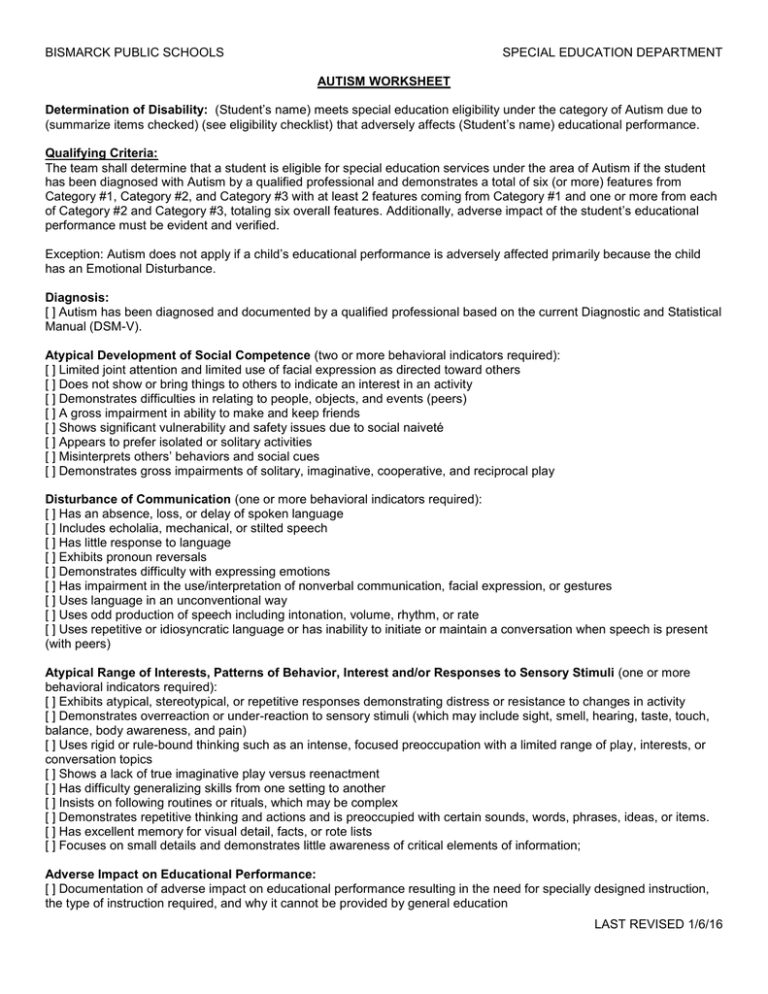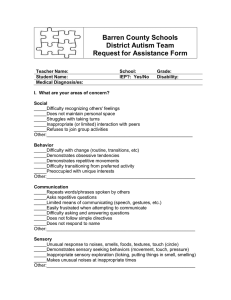Autism Worksheet
advertisement

BISMARCK PUBLIC SCHOOLS SPECIAL EDUCATION DEPARTMENT AUTISM WORKSHEET Determination of Disability: (Student’s name) meets special education eligibility under the category of Autism due to (summarize items checked) (see eligibility checklist) that adversely affects (Student’s name) educational performance. Qualifying Criteria: The team shall determine that a student is eligible for special education services under the area of Autism if the student has been diagnosed with Autism by a qualified professional and demonstrates a total of six (or more) features from Category #1, Category #2, and Category #3 with at least 2 features coming from Category #1 and one or more from each of Category #2 and Category #3, totaling six overall features. Additionally, adverse impact of the student’s educational performance must be evident and verified. Exception: Autism does not apply if a child’s educational performance is adversely affected primarily because the child has an Emotional Disturbance. Diagnosis: [ ] Autism has been diagnosed and documented by a qualified professional based on the current Diagnostic and Statistical Manual (DSM-V). Atypical Development of Social Competence (two or more behavioral indicators required): [ ] Limited joint attention and limited use of facial expression as directed toward others [ ] Does not show or bring things to others to indicate an interest in an activity [ ] Demonstrates difficulties in relating to people, objects, and events (peers) [ ] A gross impairment in ability to make and keep friends [ ] Shows significant vulnerability and safety issues due to social naiveté [ ] Appears to prefer isolated or solitary activities [ ] Misinterprets others’ behaviors and social cues [ ] Demonstrates gross impairments of solitary, imaginative, cooperative, and reciprocal play Disturbance of Communication (one or more behavioral indicators required): [ ] Has an absence, loss, or delay of spoken language [ ] Includes echolalia, mechanical, or stilted speech [ ] Has little response to language [ ] Exhibits pronoun reversals [ ] Demonstrates difficulty with expressing emotions [ ] Has impairment in the use/interpretation of nonverbal communication, facial expression, or gestures [ ] Uses language in an unconventional way [ ] Uses odd production of speech including intonation, volume, rhythm, or rate [ ] Uses repetitive or idiosyncratic language or has inability to initiate or maintain a conversation when speech is present (with peers) Atypical Range of Interests, Patterns of Behavior, Interest and/or Responses to Sensory Stimuli (one or more behavioral indicators required): [ ] Exhibits atypical, stereotypical, or repetitive responses demonstrating distress or resistance to changes in activity [ ] Demonstrates overreaction or under-reaction to sensory stimuli (which may include sight, smell, hearing, taste, touch, balance, body awareness, and pain) [ ] Uses rigid or rule-bound thinking such as an intense, focused preoccupation with a limited range of play, interests, or conversation topics [ ] Shows a lack of true imaginative play versus reenactment [ ] Has difficulty generalizing skills from one setting to another [ ] Insists on following routines or rituals, which may be complex [ ] Demonstrates repetitive thinking and actions and is preoccupied with certain sounds, words, phrases, ideas, or items. [ ] Has excellent memory for visual detail, facts, or rote lists [ ] Focuses on small details and demonstrates little awareness of critical elements of information; Adverse Impact on Educational Performance: [ ] Documentation of adverse impact on educational performance resulting in the need for specially designed instruction, the type of instruction required, and why it cannot be provided by general education LAST REVISED 1/6/16 BISMARCK PUBLIC SCHOOLS SPECIAL EDUCATION DEPARTMENT [ ] Educational needs in each category checked above is summarized in this report [ ] A minimum of one observation in the area of suspected disability was conducted and summarized in report (best practice would be three observations) Data for Determining Eligibility was gathered from: Required: [ ] Autism has been diagnosed and documented by a qualified professional (BPS requires) [ ] Observation Minimum of one additional resource: [ ] Structured interviews with parents/teachers [ ] Autism checklists/behavior rating scales [ ] Communication and developmental rating scales [ ] Functional behavior assessments [ ] Application of diagnostic criteria from the DSM-V [ ] Informal and standardized assessment instruments [ ] Cognitive testing LAST REVISED 1/6/16




